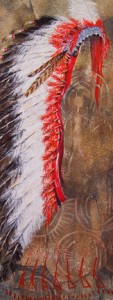Signs of Change
 “Pictograph of Change” 11 x 30” Watercolor and Gouache on Paper
“Pictograph of Change” 11 x 30” Watercolor and Gouache on Paper
Nothing remains constant. As humans we tend to resist change while at the same time, craving it. Life is uneventful without variety and change. Yet, we often cling desperately to the comfort zone we are accustomed to. As my son hits his teen angst years, I am reminded at how we seek for individuality, while at the same time, are trying to fit in, thus conform. It is a constant dichotomy.
As mankind moves through time, change of course, is a big part of the advancement of culture. Wheter for good or bad, culture changes. At no time in man’s history is there such rapid change as there is today. The information age has brought with it such rapid advancement of knowledge that is is mind-boggling to me. At the same time, it is signaling the end to a great many ways of which things have been done in the past.
Ancient rock carvings and pictograph paintings are found across North America. These mysterious images hold profound meaning as well as questions. The rock carvings depicted in this artwork are adapted from those found in the Wind River Basin in Wyoming. By etching a mark into the stone, it is believed that early people were making a symbol of permanence which bonded them to the sacred powers of the earth.
While creating this piece, a prehistoric rock carving depicting a person took on additional meaning for me. Selecting petroglyphs to include with the war bonnet, I was startled to realize an image I’d often seen before, now had clear meaning. I knew instantly: it depicted a warrior with a feathered headdress. Each pictograph and rock carving held stories long ago lost to time.
The Castle Garden site in Wyoming depicts many shield images, which are rendered in this artwork. The more “modern” painted imagery at the bottom of the painting depicts guns and hash marks, which represent kills. Painted pictographs are not as old as carved images and are often painted over more ancient imagery. These pigmented depictions are as seen at the Pictograph Cave State Park, near Billings, Montana.
A representative icon from the past is a Sioux feathered headdress. Stately and proud, the headdress, or war bonnet, was a status symbol to the Plains Indians. Each feather was a reward for a deed in battle, and each also held a story.